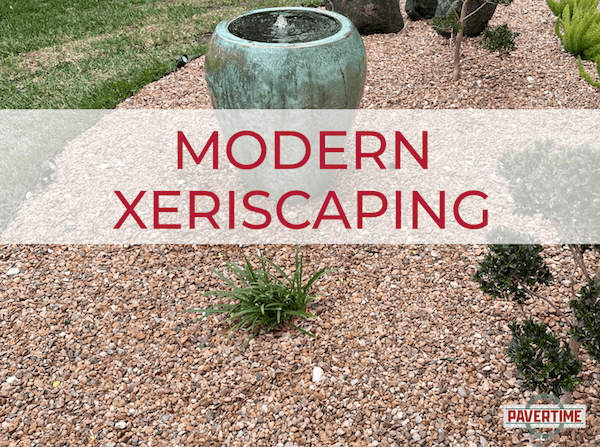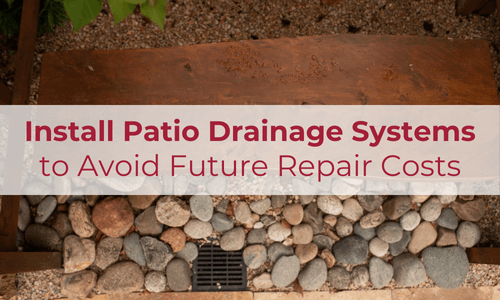Modern xeriscaping is a method of landscaping that is based on native plants. Unlike traditional landscape designs, xeriscaping uses drought-tolerant plants. These plants are native to the Houston area and are best adapted to its climate.
When hardscaping like pavers or retaining walls are included, the resulting landscape design can be extremely attractive and low-maintenance, creating a lush look that uses very little water. Once you’ve determined the best plants and materials to use, the Pavertime team can help with the draining, gravel, and pavers to complete and compliment your xeriscaping project with high-quality hardscaping.
For homeowners looking to save money on their waterbills without compromising the look of a gorgeous yard, modern xeriscaping is a great option as it uses fewer water resources, which is especially important in times of drought.
The Seven Principles of Modern Xeriscaping
According to the Texas Agricultural Extension Service, there are seven principles of modern xeriscaping.
1. Planning and Design
In order to achieve the best results with xeriscapes, a careful plan must be created. This should involve an evaluation of the site and proper soil amendment. The plants should be grouped according to their water-requirement needs.
Several materials can be used to create a water-saving outdoor space, including pavers and stone. Pavers and stone can be laid in varying sizes and spacing to create geometric interest and promote natural rainwater flow between steps.
You’ll need to map out your yard and think about where the sun and shade will fall. You also need to consider the hardscape of your yard. Sound daunting? It doesn’t have to be. Pavertime can help you create a detailed plan that incorporates a beautiful design for your lawn areas.
2. Soil Analysis
A good xeriscape design should include good soil management. A well-draining soil is essential for drought-tolerant plants.
Houston’s soil is a mixture of gumbo clay and sand. The gumbo clay is found in the eastern and southern parts of the city, while the sand is found in the western and northern parts. This mixture of soil types makes Houston’s soil very fertile and ideal for growing a variety of plants and crops.
The gumbo clay helps to retain moisture and nutrients, while the sand provides drainage and aeration. This combination of soil types makes Houston’s soil some of the best in the country for growing a wide variety of plants and crops.
If you’re not certain if your soil is sufficient for modern xeriscape design, you can also test your soil by purchasing a soil testing kit from a local home improvement store. This testing determines whether soil improvement is needed for better water absorption and improved water-holding capacity. If soil testing seems like too much of a hassle, the Pavertime team will be more than happy to provide their expert opinions on the type of soil on your property.
3. Practical Grassy Areas
Another important aspect of xeriscaping is reducing the size of grassy areas, since these areas require a lot of water to stay green and fresh – water that can best be used for other purposes.
In this way, you’ll have room for food plants, as well as other plants that require little water. Using native plants and desert-adapted species will minimize your need for water. Avoid impractical grass use, such as long, narrow areas.
4. Appropriate Plant Selection
Using native plants is another key component of xeriscaping. Not only will they make your yard look beautiful, but they will also create a home for native wildlife. Despite a lack of water, native plants that are already adapted to the Houston climate are the ideal solution for a yard without grass.
According to this article at PBS.org, “The Texas Native Plant Society [also called the Native Plant Society of Texas, or NPSOT], one of many similarly named societies across the country, promotes the conservation and use of native plants and provides educational resources and workshops for homeowners and growers in the state.”
NPSOT also has a list of plants native to the Houston region that you can refer to when choosing plants for your modern xeriscape design. Another great point in their favor is that Texas homeowner’s associations are prohibited by law from requiring homeowners to get rid of native plants.
5. Efficient Irrigation
Modern xeriscaping is a type of landscaping that is extremely water efficient. This means it uses the natural rainfall as the only irrigation, or sometimes methods that are efficient in their use of water, such as drip irrigation.
In addition to the potential benefits, xeriscaping is an environmentally friendly alternative to lawns. It can save homeowners thousands of dollars by reducing their water consumption. In some cases, a properly designed xeriscape can reduce water usage by up to 50%.
6. Mulching
Mulching is an important part of xeriscaping, especially in Houston where water conservation is crucial. By covering the ground with a layer of organic material, mulch helps reduce evaporation, regulate soil temperature, and prevent weed growth. This not only helps your xeriscape look neater and more manicured but also requires less water and maintenance. There are many types of mulch available, so be sure to choose one that is appropriate for your climate and plants. Shredded native mulch is a great choice for Houston residents.
Most xeriscape plants are low-maintenance and require only occasional fertilization. To achieve the best results, you should remove dead or diseased foliage and ensure that the soil receives sufficient airflow.
7. Appropriate Maintenance
Although xeriscaping requires less water than traditional landscaping, it still needs some maintenance. Here are some tips for modern xeriscaping maintenance:
- Water your xeriscape early in the morning or late in the evening to minimize evaporation.
- Use a soaker hose or drip irrigation system to deliver water directly to the roots of plants.
- Prune your plants regularly to encourage new growth and maintain their shape.
- Fertilize your plants every few months to ensure they get the nutrients they need.
Conclusion
Modern xeriscaping is a type of landscape design that is both beautiful and low maintenance. Unlike a grassy lawn, it doesn’t require watering or fertilizing. It’s also more affordable than traditional landscapes. Whether you live in a high-desert area or a moderately moist area, xeriscaping can make your home look beautiful.
For instance, xeriscaped yards require less water, fertilizer, and pest control measures. Using pesticides and fertilizers is expensive and can cause adverse effects on other organisms in the area. Aside from saving money, xeriscaping is an excellent option for Houston homeowners who want to save water, help the environment, and reduce their maintenance costs.
If you’re interested in converting your current landscape to a water-efficient, drought-resistant oasis, modern xeriscaping is the best option for you! When you’re ready to add hardscaping to the mix, give our team of experts a call! We’re here to assist you with every step of the hardscape process, from planning and design to appropriate maintenance.





